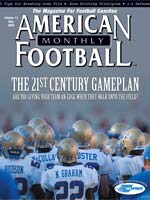AMERICAN FOOTBALL MONTHLY THE #1 RESOURCE FOR FOOTBALL COACHES
Article CategoriesAFM Magazine
|
Technology and Your Budget: Hints and Suggestionsby: Richard Scott© More from this issue NFL teams are spending millions on video technology and complex computer systems. Division I-A teams are spending hundreds of thousands on their own versions of the same technology. So what? What does that mean for NCAA Division II and III, NAIA, junior college and high school programs with limited budgets and resources? Do you find yourself at clinics and conventions walking right past the tech booths and ignoring the tech seminars, afraid you’ll never be able to comprehend and operate such a system, let alone afford one? “A big-time program can make mistakes, so I don’t want to hear what some big-time school is doing,” says Jim Gagliardi, the offensive coordinator at Saint John’s (Minn.) University. “It doesn’t matter what they’re doing because they ....The full article can only be seen by subscribers.
|
|
|||||||
| HOME |
MAGAZINE |
SUBSCRIBE | ONLINE COLUMNISTS | COACHING VIDEOS |
Copyright 2025, AmericanFootballMonthly.com
All Rights Reserved





